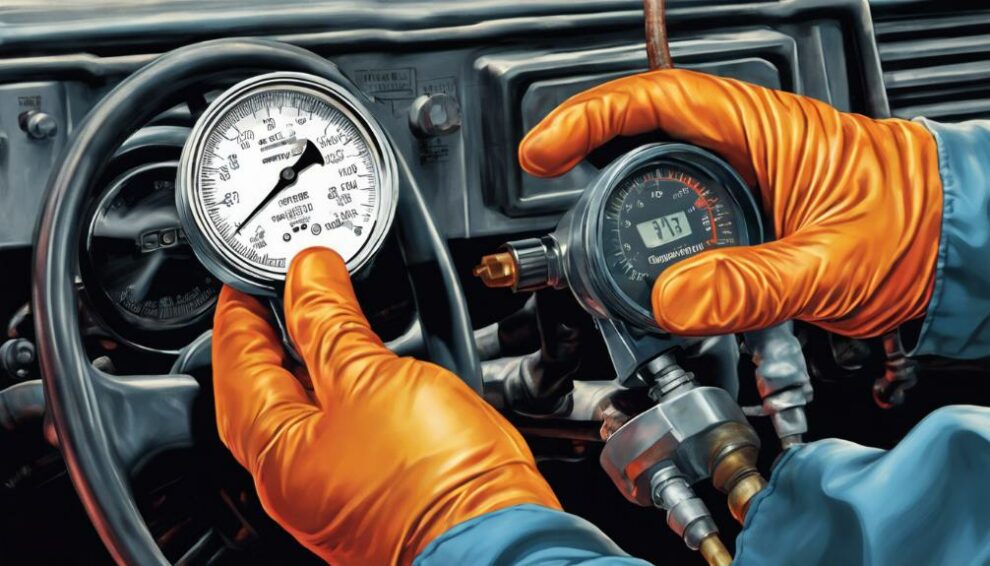If you’re facing the P0876 code, it may signal Transmission Fluid Pressure Sensor/Switch D Circuit Range/Performance issues. Calibration is key for accurate pressure readings.
Incorrect calibrations can trigger the code due to voltage discrepancies affecting sensor performance. Common symptoms include harsh shifting, slippage, or abnormal gear starts.
Potential culprits are wiring faults, sensor damage, or low fluid levels impacting pressure readings. Use an OBD-II scanner to pinpoint the problem, check sensor integrity, and assess fluid levels.
Prompt attention can avert severe transmission damage. Understanding these troubleshooting steps is essential for resolving P0876 efficiently and effectively.
What You Need to Know
- Use OBD-II scanner for error retrieval.
- Troubleshoot sensor, wiring, and connections.
- Test fluid level and condition.
- Ensure proper sensor calibration for accurate readings.
- Consider replacing faulty transmission fluid pressure sensor.
Understanding P0876 Transmission Code

If you encounter the P0876 transmission code, it signals potential issues with the Transmission Fluid Pressure Sensor/Switch D Circuit Range/Performance.
Sensor calibration is essential in ensuring the accurate measurement of transmission fluid pressure. Improper calibration can lead to erroneous voltage readings, triggering the P0876 code.
Voltage readings play an important role in determining the performance range of the sensor/switch circuit.
Inaccurate readings may indicate a malfunction in the sensor or switch, causing the transmission to experience issues like harsh shifting or slippage.
Proper diagnosis involves checking the sensor’s calibration and verifying the voltage readings to pinpoint any discrepancies. Addressing these issues promptly can prevent further damage to the transmission system.
Symptoms of P0876 Code
When experiencing the P0876 transmission code, watch out for symptoms like harsh shifting and transmission slippage.
These signs can indicate a transmission sensor malfunction or issues with fluid pressure troubleshooting.
The code may trigger the Malfunction Indicator Light (MIL) to illuminate, warning you of a potential problem. If your vehicle starts off in 2nd or 3rd gear unexpectedly, it could be a clear indicator of trouble.
Changes in shift quality, such as jerking or delayed engagement, are common symptoms associated with P0876.
Ignoring these symptoms can lead to further transmission issues and potential damage. It’s essential to address these symptoms promptly to prevent more severe problems down the line.
When you notice any of these indicators, consider seeking professional help to diagnose and resolve the underlying transmission issue efficiently.
Causes of P0876 Transmission Issue

One common cause of the P0876 transmission issue is wiring faults affecting the transmission fluid pressure sensor/switch circuit.
When these wiring faults occur, it can disrupt the communication between the sensor and the vehicle’s control modules, leading to erroneous pressure readings.
Also, sensor troubleshooting is vital in diagnosing the P0876 code. Issues with the sensor itself, such as malfunctions or damage, can also trigger this code.
Making sure that the sensor is functioning correctly is essential for accurate pressure readings and proper transmission operation.
Another potential cause of the P0876 code is low transmission fluid levels. Insufficient fluid can result in inadequate pressure within the transmission system, causing the sensor to detect abnormalities.
As a result, fluid level inspection is necessary when encountering this issue. Checking and maintaining the proper fluid levels can help prevent the onset of the P0876 code and ensure smooth transmission performance.
Diagnosing P0876 Code
To diagnose the P0876 code, start by using an OBD-II scanner to retrieve the error information. Once you have the code, proceed with sensor troubleshooting techniques.
Inspect the wiring, connections, and the transmission fluid pressure sensor itself. Testing the transmission fluid level and condition is essential in diagnosing P0876, as it can impact sensor performance.
Also, fluid pressure testing methods should be employed to make sure the sensor is functioning within the correct parameters.
Clearing the code after any repairs are completed is essential, followed by test driving the vehicle to confirm that the issue has been resolved.
By systematically checking the sensor, connections, and fluid levels, you can pinpoint the source of the problem related to the P0876 code.
Proper diagnostics and testing methods are key to accurately diagnosing and addressing transmission fluid pressure sensor issues.
Repairing P0876 Transmission Problem

Repairing the P0876 transmission problem typically involves diagnosing the root cause and addressing it promptly to prevent further issues.
To start, consider replacing the transmission fluid pressure sensor to resolve the P0876 code.
This sensor is important for proper transmission function, and a malfunction can lead to issues like harsh shifting and transmission slippage.
Then, it’s essential to inspect the wiring connected to the sensor for any damage or loose connections. Faulty wiring can also trigger the P0876 code and affect the sensor’s readings.
By replacing the sensor and ensuring the wiring is intact, you can often rectify the transmission problem associated with P0876.
Remember, addressing these issues promptly can prevent more severe transmission damage and costly repairs down the line.
Preventing Future P0876 Troubles
Inspecting your vehicle’s transmission fluid levels regularly can help prevent future P0876 troubles. Proper fluid maintenance is vital in avoiding issues related to Code P0876.
Address any leaks promptly to prevent low fluid conditions that can trigger the P0876 code.
Also, it’s important to inspect wiring and connectors for any damage or wear to prevent sensor troubleshooting and transmission problems.
Consider replacing filters and performing fluid flushes as part of preventive maintenance measures to keep your transmission system in excellent condition.
Stay vigilant for symptoms like harsh shifting or transmission slippage, as these can be early indicators of potential P0876 issues.
As an Amazon Associate we earn from qualifying purchases.










